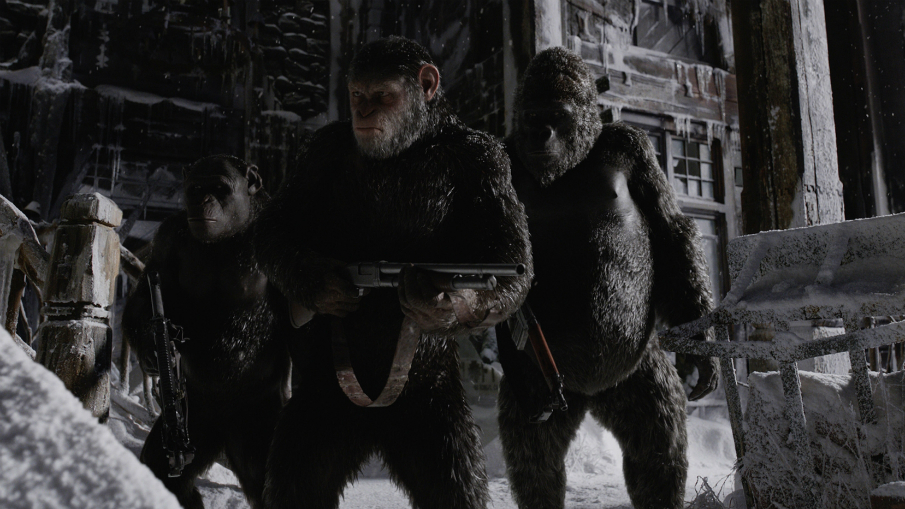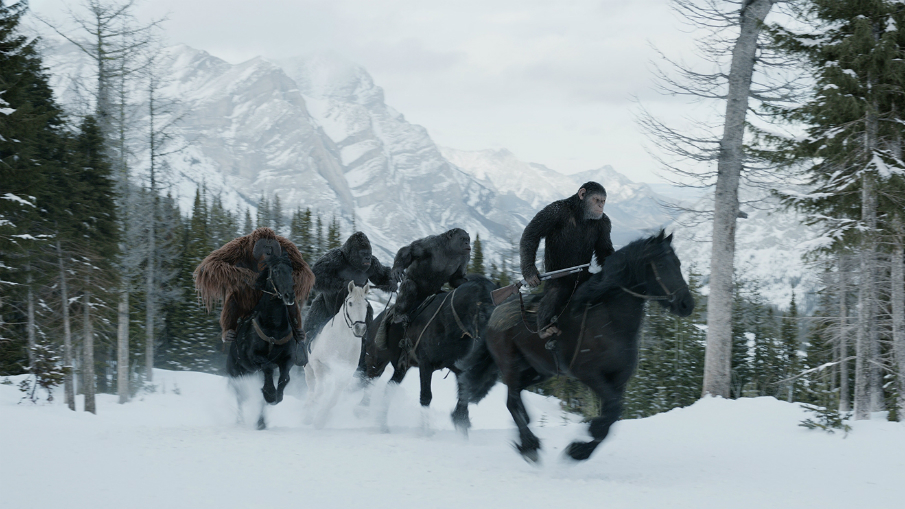Combining the emotional resonance of 2011’s Rise of the Planet of the Apes with the post-apocalyptic action of 2014’s Dawn of the Planet of the Apes, the third film in the reboot trilogy creates a richly satisfying experience on both a technical and philosophical level. It is the rare summer blockbuster that gives you important themes to chew on and debate alongside a huge helping of electrifying fight sequences. It may not be the escapist fun of Marvel’s superhero sequels and reboots, but if offers such cathartic energy to the “war is hell” trope that it truly stands out from other summer offerings. It’s the kind of movie that will leave you in stunned silence as you watch the credits roll, needing to compose yourself for a few minutes before leaving the theater.
The themes and references of War for the Planet of the Apes also set it apart from big summer tentpoles. The film has the overall feeling of a Shakespearean tragedy and includes allusions to The Bible, with chimp leader Caesar (Andy Serkis) serving as a Christ-like figure, and the war classic Apocalypse Now, as Woody Harrelson plays a character very similar to Marlon Brando’s Colonel Kurtz.

The visual effects in War are extremely lifelike, to the point where you barely even separate the incredible CGI detail of the apes from the real-life background. This is only helped by Serkis’ lived-in performance as Caesar. You see the pain and loss in his eyes as he struggles to muster up the strength to do what’s right and save his ape colony. Those who have seen the previous two films have watched Caesar’s growth from curious young chimp to world-weary commander, and Serkis inhabits this growth so naturally. He’s older now, but he carries himself with the wisdom and charisma of a natural-born leader who has gained the undying trust of his community.
Media outlets have now started campaigning for Serkis to finally be nominated for an Oscar. The Academy has yet to embrace motion capture performances as an achievement worth rewarding, for a few reasons. The Oscars have traditionally had a bias against the kinds of movies that require motion capture and any kind of visual effects, The Lord of the Rings trilogy aside. But more importantly, as AwardsDaily’s Sasha Stone keenly observes, the art of motion capture terrifies many actors. After all, their face and the body they inhabit are their money-makers, and it’s easy to imagine a future where actors are enhanced technologically, and that’s assuming they will even be needed at all if their likeness is digitally recreated. There is a feeling that the “reality” is lost, and traditional actors are already anxious enough about the dominance of visual effects and animation in their industry to begin with.
Meanwhile, Serkis has defended mo-cap against claims that it is any less of an achievement than a traditional performance.
“The acting community has worries about motion capture because they believe it’s some form of replacement for performance when in fact, it’s the opposite,” he told Wired in 2012. “Motion capture is a tool that allows actors to transform themselves into many different characters. You’re not confined by physicality. You can play anything.”
He had previously told the magazine that while his performance as Gollum in The Lord of the Rings trilogy was assisted by computer animation, it was not unlike John Hurt’s prosthetics-assisted performance in 1980’s The Elephant Man, which earned him an Oscar nomination.
“For The Elephant Man, a whole team of prosthetics artists worked on John Hurt’s character to help him create that performance. Whether or not the Academy can learn to see ones and naughts as a digital form of prosthetics — that is the question,” Serkis said.
If Serkis does not sustain enough buzz to get an acting nomination for War for the Planet of the Apes, his best shot may be the Academy Honorary Award, given out by the Academy’s Board of Governors. The honor celebrates artists for achievements not recognized by the competitive Oscar categories, and it’s hard to argue that Serkis is not richly deserving of such an award, given his illustrious career as a motion capture artist. Even if he is not recognized this year, the award is not reliant on an eligible film for that specific year so he could be awarded at any point in the future.

The Oscar for Outstanding Visual Effects is much more in reach for War for the Planet of the Apes. There is precedent in this category for the franchise, with both Rise and Dawn receiving nominations, but both films lost to Hugo and Interstellar, respectively. Other contenders in this year’s Visual Effects category will likely be Blade Runner 2049, Star Wars: The Last Jedi, and Transformers: The Last Knight, but even with such major visual achievements as its competition, the effects of War for the Planet of the Apes are pretty undeniable. Weta Digital, the company behind Planet of the Apes series, has already won five Oscars (for the three Lord of the Rings films, 2005’s King Kong, and 2009’s Avatar), but it is certainly overdue for a trophy for creating such rich, visually-stunning apes.
Yet, even if War for the Planet of the Apes does not end up winning any Oscars, the film has already helped establish the modern Apes reboot as one of the best trilogies of the 21st century, and Serkis’ contributions will be renowned for years to come.

